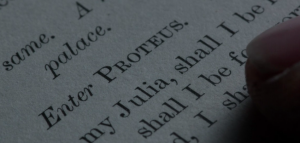Research Abstract
Defining Modern-Day Monstrosity Through Trump-Era Rhetoric
How is the word “monster” getting associated with Trump’s body? What does this say about modern-day conceptions of monstrosity and widespread cultural anxieties? Classical monster theorists Jeffery Cohen and Scott Poole help ground the criteria for monstrous behavior. Cohen sets up seven theses each with regard to another function of a monster. For the purposes of my paper, I will be focusing on the translation of the first five theses of monstrosity from Cohen in correlation with Trump. Trump crosses lines of ethicality, civility, and even humanity and begins to bleed into the monstrous realm. In this way, Trump becomes dehumanized—not in ways that he  uses to justify violence against women or immigrants—but dehumanized because he takes the form more reminiscent of a monster, as characterized by Cohen, than a human. However, the language of monstrosity is not solely used to describe Trump. This language is being used expansively over the political landscape of the United States. Now, monstrosity acts as symbol of vilification and extreme division not only across party lines, but also class, gender, and race.I argue that monstrous discourse serves to limit our humanity into boxes of good and bad, heroes and villains, strength and weakness, fearless and fearful. When this happens, our society risks losing our capacity to communicate, trust,empathize, and do the things that drive us away from monstrosity and catapult us into a mode of compassion.
uses to justify violence against women or immigrants—but dehumanized because he takes the form more reminiscent of a monster, as characterized by Cohen, than a human. However, the language of monstrosity is not solely used to describe Trump. This language is being used expansively over the political landscape of the United States. Now, monstrosity acts as symbol of vilification and extreme division not only across party lines, but also class, gender, and race.I argue that monstrous discourse serves to limit our humanity into boxes of good and bad, heroes and villains, strength and weakness, fearless and fearful. When this happens, our society risks losing our capacity to communicate, trust,empathize, and do the things that drive us away from monstrosity and catapult us into a mode of compassion.
Capstone Description
The Technology of Names: What We Can Learn About Humanity by Naming Monsters
Our society seems obsessed with naming: constellations, people, planets, hurricanes, etc. But what does it mean when we name monsters? Is naming a way to dilute our fear of monsters or a is it mere expression of power over them? By analyzing a clip from Penny Dreadful’s episode “Séance” wherein Victor gives Proteus the illusion of naming himself, I assert that naming is another effort to colonize and control therefore extending the reach of man. Frankenstein’s monster is constructed from the parts of old bodies and creates a being that  defies death and achieves immortality. In doing so, Frankenstein also achieves a form of immortality by leaving his name to alter history and be remembered as the champion of death. Mary Shelly’s Frankenstein leaves the creature forever unnamed, intensifying its alienation from society. In this 2014 reinterpretation of Shelley’s Frankenstein, the creature chooses his name of Proteus from a Shakespearean play. Naming creatures that challenge our neat definitions or blur borders between categories is, as Jeffrey Cohen famously argued, a hallmark of monstrosity.
defies death and achieves immortality. In doing so, Frankenstein also achieves a form of immortality by leaving his name to alter history and be remembered as the champion of death. Mary Shelly’s Frankenstein leaves the creature forever unnamed, intensifying its alienation from society. In this 2014 reinterpretation of Shelley’s Frankenstein, the creature chooses his name of Proteus from a Shakespearean play. Naming creatures that challenge our neat definitions or blur borders between categories is, as Jeffrey Cohen famously argued, a hallmark of monstrosity.